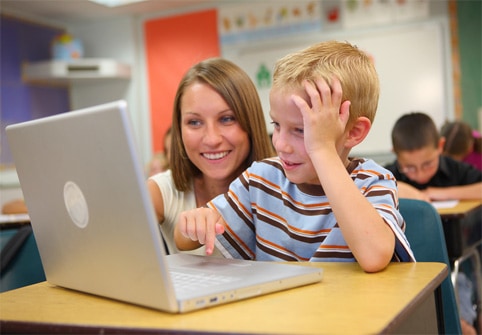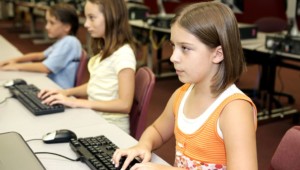Blended Learning Model Helps Students

“Blended Learning Model Helps Students Elaborate, Extend, Apply, and Transfer Knowledge” by Arthur VanderVeen was originally posted on Navigator.
All of us in public education know that budget constraints are real. Educators are having to do more with less. This is the new normal.
Unfortunately, our K-12 schools are still largely organized to manage the old normal; the traditional 19th century classroom, with one teacher/lecturer and 23 to 34 students/consumers.
However, there are courageous educators around the country who understand that every year of poor instruction has lasting, lifelong impacts on kids’ futures. With a healthy sense of urgency, these educators are disrupting the antiquated model of classroom management, and facilitating and fostering the ability for teachers, students, and technology to all work together to propel learning forward.
Their driving objective is to empower teachers to be more efficient and effective with ever-diminishing resources and ever-growing student numbers and shifting demographics.
Many of these education leaders are discovering blended learning models are a powerful strategy that can help them meet their objective. Blended learning most commonly takes the form of technology and teaching informing each other. The technology provides teachers with valuable student data they can use to flexibly and fluidly group students and guide student-centered learning. Students typically alternate between engaging with teachers, working in peer groups and individually, and focusing on online content tailored to their specific learning needs, abilities, and interests.
Teachers can leverage the technology to help build foundational knowledge and skills, which, in turn, allows them more time to do what they do best: engage with students to apply, deepen, and extend their base knowledge. Additionally, the more meaningful, small group and one-on-one interactions that blended learning allows, enable teachers to encourage communication, collaboration, creativity, and critical thinking skill development.
In the book How People Learn: Brain, Mind, Experience, and School internationally renowned learning scientist John Bransford characterizes learning as elaborating, extending, applying, and transferring knowledge to new contexts. This is the core of the “knowledge worker” who can solve new problems and succeed in new jobs that we can’t even envision yet.
Nobel laureate Herbert Simon is quoted in the book as stating “…the meaning of ‘knowing’ has shifted from being able to remember and repeat information to being able to find and use it.”
The authors elaborate, “More than ever, the sheer magnitude of human knowledge renders its coverage by education an impossibility; rather, the goal of education is better conceived as helping students develop the intellectual tools and learning strategies needed to acquire the knowledge that allows people to think productively about history, science and technology, social phenomena, mathematics, and the arts. Fundamental understanding about subjects, including how to frame and ask meaningful questions about various subject areas, contributes to individuals’ more basic understanding of principles of learning that can assist them in becoming self-sustaining, lifelong learners.”
So, perhaps the greatest benefit our teachers glean from a blended learning environment is precious time and meaningful data, enabling them to develop in students these intellectual tools and learning strategies.
Finally, because blended learning is so transformative, making it work takes vision, school leadership, union cooperation, ongoing professional development, and most importantly, teacher buy-in. Some educators are clinging to the old model of teaching, out of fear. Fear of losing control of the classroom, because in a blended environment students share the responsibility for deciding what’s being taught and when. And fear of being replaced by technology, even though we know, rationally, that teachers simply cannot be replaced in the classroom. Period.
And, once educators get acclimated with the blended learning model, they realize they can maximize learning time, differentiate instruction, and achieve a total view of student progress. Yes, good teachers have been doing this since the dawn of time; the technology just makes the process exponentially quicker and easier, allowing teachers to do so much more with far less.
Arthur VanderVeen is the vice president of business development and strategy at Compass Learning. As the former district administrator in New York City, Arthur founded and led the NYC Innovation Zone (iZone), an active community of 165 schools using digital technologies and innovative instructional approaches to personalize learning to the needs of individual students. Under his direction, the iZone launched the largest district-level, online and blended learning program in the country. Arthur earned his Ph.D. in English from the University of Texas at Austin, his master’s degree in divinity in educational psychology from the Princeton Theological Seminary, and his bachelor’s degree in English from Colorado College.
CompassLearning is a Getting Smart Advocacy Partner.







0 Comments
Leave a Comment
Your email address will not be published. All fields are required.